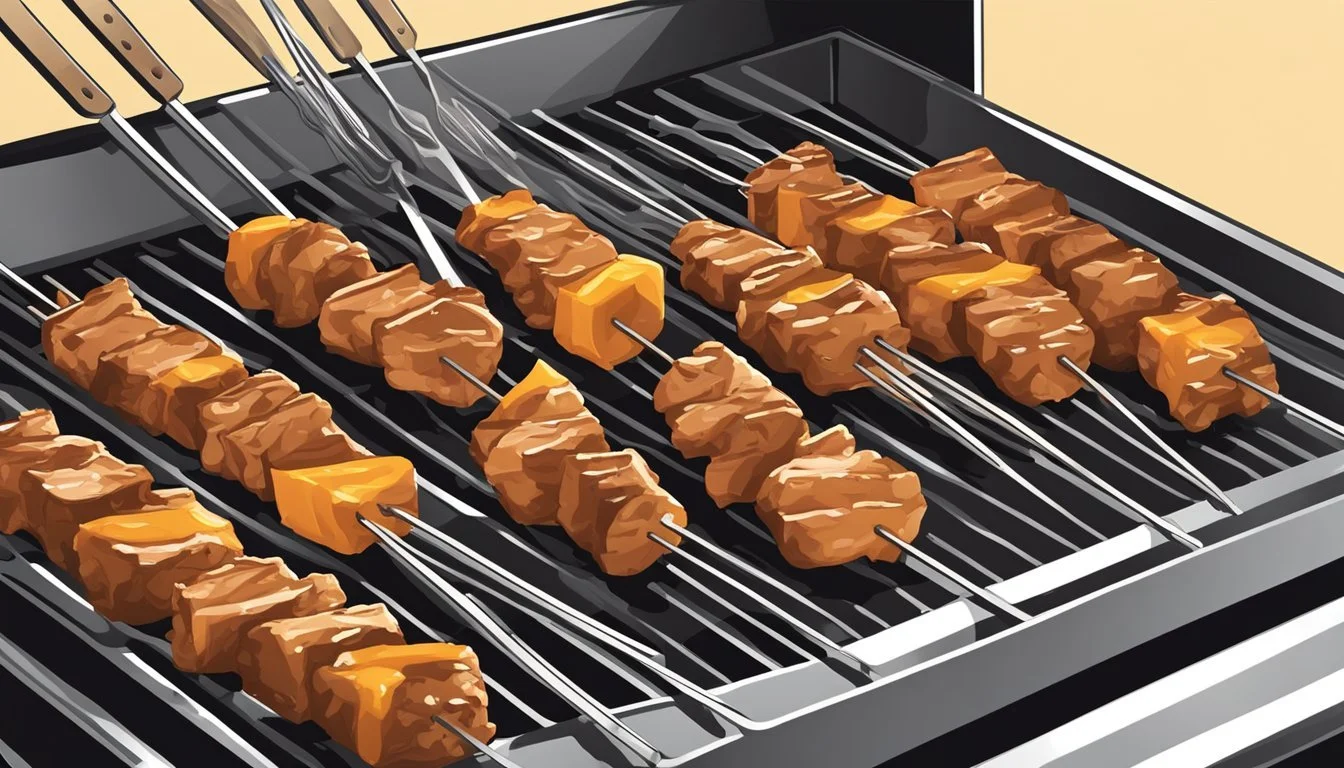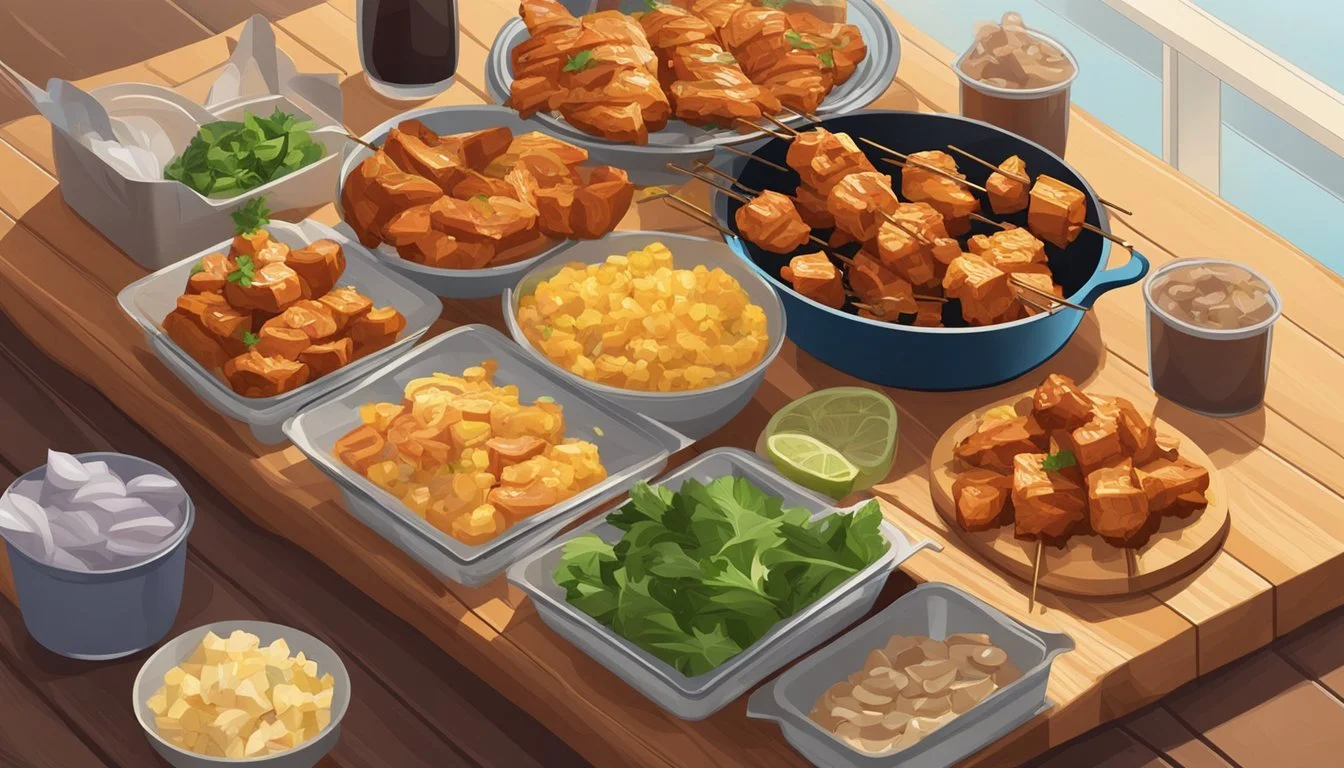How to Reheat BBQ Chicken Skewers for Perfect Taste and Texture
Barbecue chicken skewers are a treat that many enjoy fresh off the grill, but figuring out how to best reheat them can be a bit tricky. The key to successfully reheating leftover chicken skewers without losing their delicious flavor or tenderness lies in using the right method. Whether you opt for the oven, grill, or stovetop, the goal is to ensure the chicken reaches an internal temperature of 165°F to be safe to eat.
Using an oven is a popular choice for evenly reheating your skewers. Preheat the oven to 350°F and place the chicken skewers on a baking sheet lined with foil. Cover the skewers loosely with another piece of foil to maintain moisture and bake for around 10-15 minutes. This method helps maintain the delicious flavors of the barbecue sauce without drying out the chicken.
For a slightly smoky taste, reheating on a grill can be quite effective. Preheat the grill to medium heat and brush the grates with oil to prevent sticking. Place the skewers on the grill and cook for about 5-7 minutes per side, ensuring the internal temperature reaches 165°F. This method revives the fresh-off-the-grill flavor that makes barbecue chicken skewers so irresistible.
Choosing the Right Reheating Method
When it comes to reheating BBQ chicken skewers, each method has its unique advantages in terms of efficiency, moisture retention, and flavor enhancement. Below, you will find detailed guidance on different reheating methods tailored to various kitchen appliances and tools.
Oven Reheating
Preheat the Oven: Begin by preheating the oven to 350°F (175°C). The consistent heat ensures even reheating without drying out the chicken skewers.
Preparation: Place the chicken skewers on a baking sheet lined with aluminum foil or parchment paper. Lightly cover the skewers with another piece of foil to retain moisture.
Reheating Process: Bake the skewers for about 10-15 minutes or until the internal temperature reaches 165°F (74°C). Use a meat thermometer for accuracy. This method preserves the juicy texture and enhances the smoky flavor of the BBQ chicken skewers.
Microwave Reheating
Preparation: Place chicken skewers on a microwave-safe plate. Cover the plate with plastic wrap, leaving a small gap for steam to escape.
Microwave Settings: Use medium-high power settings, typically around 80% wattage, to avoid overcooking. Reheat for 3-4 minutes, checking halfway through to rearrange the skewers for even heating.
Moisture Retention: To prevent dryness, consider placing a small bowl of water inside the microwave. This helps create a steamy environment, maintaining the moisture and tenderness of the chicken.
Grill Reheating
Preheat the Grill: Set the grill to medium heat. Higher temperatures can cause the chicken to burn on the outside while staying cold inside.
Preparation: Lightly brush the skewers with olive oil or leftover marinade to prevent sticking and enhance flavor. Place the chicken skewers directly on the grill grates.
Reheating Process: Grill the skewers for 5-7 minutes, turning them occasionally to ensure even heating. The grill adds a fresh smoky flavor and can crisp up the skin if desired.
Stovetop Reheating
Preparation: Heat a non-stick frying pan over medium heat. Add a small amount of olive oil to prevent sticking and enhance the flavor of the chicken.
Reheating Process: Place the chicken skewers in the pan and cover with a lid. This helps retain moisture. Reheat for about 5-7 minutes, turning the skewers occasionally until the chicken is heated through.
Cooking Spray: Using a cooking spray can further prevent sticking and simplify cleanup.
Air Fryer Reheating
Preparation: Preheat the air fryer to 350°F (175°C). Lightly spray the air fryer basket with cooking spray to prevent sticking.
Reheating Process: Place the chicken skewers in a single layer in the basket. Avoid overcrowding to ensure effective air circulation. Reheat for 8-10 minutes, checking halfway through to turn the skewers.
Crispy Skin: This method can help achieve a crispy texture while keeping the inside juicy, making it a popular choice for reheating BBQ chicken skewers.
By following these guidelines, each method will help you enjoy your BBQ chicken skewers with the best possible taste and texture.
Preparing Chicken for Reheating
Proper preparation ensures that barbecue chicken skewers are safe to eat and retain their delicious flavor and texture. This section covers essential steps to maintain juicy tenderness and ensure cooking safety.
Thawing Frozen Chicken Skewers
To safely thaw chicken skewers, it is recommended to use the refrigerator. Place the frozen skewers in an airtight container to avoid cross-contamination. Allow 24 hours for the chicken to defrost fully.
For a quicker method, use the microwave. Set it to the defrost setting and observe the chicken closely. Rotate the skewers occasionally to ensure even thawing. Avoid keeping the chicken in the microwave long enough to start cooking, as this can affect texture.
Another method is cold water thawing. Seal the skewers in a leak-proof bag and submerge them in cold water, changing the water every 30 minutes. This process takes about 1-3 hours, depending on the skewer thickness.
Marinating for Enhanced Flavor
Enhancing flavor through marination can infuse the chicken with renewed taste. Combine oil, garlic powder, smoked paprika, and a pinch of salt in a bowl to create a simple marinade. Let the skewers soak for at least 30 minutes, or overnight for deeper flavor penetration.
Using a ready-made sauce or marinade is also effective. Brush barbecue sauce generously over the chicken before reheating. This can help retain moisture and add a layer of flavor.
Marinating techniques are especially useful for boneless, skinless chicken as they tend to dry out faster. Ensure each skewer is evenly coated to prevent any parts from drying.
Bringing Chicken to Room Temperature
Before reheating, let the chicken skewers come to room temperature for about 20-30 minutes. This helps the chicken heat evenly and reduces reheating time, maintaining the juicy tenderness of the meat.
Place the skewers on a clean plate. Avoid leaving the chicken out for too long to minimize the risk of bacterial growth. Cover the plate lightly with foil or a clean cloth to prevent it from drying out or attracting contaminants.
These steps are crucial for maintaining food safety while preparing the chicken for reheating. Ensuring the chicken is at an appropriate temperature helps achieve an even reheating process and prevents overcooking.
Maintaining Juiciness and Flavor
Reheating BBQ chicken skewers while retaining their juiciness and flavor involves smart use of sauces and proper heat management techniques.
Using Sauces and Marinades
Applying sauces and marinades can significantly enhance the juiciness and flavor of BBQ chicken skewers during reheating. Basting the skewers with a mixture of barbecue sauce and a small amount of olive oil before placing them in the oven keeps the meat moist.
A light brushing of olive oil can help to lock in moisture and prevent the chicken from drying out. Utilize your favorite barbecue sauce or an oil-based marinade to maintain juicy tenderness. Make sure to brush on the mixture evenly across all sides.
Covering with Foil to Retain Heat
Covering the skewers with aluminum foil ensures even heat distribution and prevents them from drying out. Loosely wrapping the skewers with foil creates a mini-steam environment, which aids in moisture retention.
Place the skewers on a baking sheet lined with foil, then cover them lightly with another piece of foil. This method helps maintain the desired juicy tenderness while ensuring that the chicken is heated through properly. Ensure the internal temperature reaches at least 165°F (74°C) for safe consumption.
Checking for Safe Consumption
When reheating BBQ chicken skewers, guaranteeing safe consumption is crucial. Ensuring that the chicken reaches a safe internal temperature and checking for specific visual cues are vital steps in this process.
Using a Meat Thermometer
To confirm that BBQ chicken skewers are safe to eat, a meat thermometer is essential. The internal temperature of the chicken must reach at least 165°F (74°C). This temperature ensures harmful bacteria like Salmonella and Campylobacter are eliminated.
Using an instant-read thermometer helps in getting quick, accurate readings. Insert the probe into the thickest part of the chicken skewer, avoiding contact with the skewer stick to get an accurate reading.
Frequent checks throughout the reheating process can prevent undercooking. Proper use of a meat thermometer promotes food safety and ensures the chicken is thoroughly heated.
Identifying Visual Cues
Visual inspection aids in determining if BBQ chicken skewers are reheated correctly. Properly reheated chicken should have a uniform texture and color.
The color should be consistent, with no pink hues visible. Any juices running from the meat should be clear rather than reddish or pink.
Texture is also a key indicator. The meat should be firm and not rubbery to the touch. Checking for these visual cues acts as an additional measure alongside using a meat thermometer, enhancing the overall safety of the BBQ chicken skewers.
Serving and Pairing Suggestions
BBQ chicken skewers are versatile and can be paired with a variety of sides and used in creative leftover recipes. Here are some specific ideas for creating delicious meals with BBQ chicken skewers.
Accompaniments for BBQ Chicken Skewers
Salads: Pair the skewers with a fresh, crisp salad. A Caesar salad or a mixed greens salad with a tangy vinaigrette complements the smokiness of the BBQ chicken.
Side Dishes: Grilled vegetables like bell peppers, zucchini, and corn make excellent sides. Coleslaw provides a refreshing, crunchy contrast.
Grains: Consider serving with rice pilaf, couscous, or quinoa. These grains absorb the juices from the chicken and enhance the meal.
Pasta: A pasta salad with a light dressing can be both filling and refreshing, adding variety to the plate.
Bread: Serve with garlic bread or a warm baguette to soak up any extra sauce.
Creative Ways to Use Leftover Chicken
Wraps: Use shredded BBQ chicken in a tortilla wrap with lettuce, tomatoes, and a drizzle of ranch or Caesar dressing. This makes a quick and easy lunch or snack.
Sandwiches: Build a hearty sandwich with leftover chicken, some cheese, and fresh veggies. For an extra kick, add a slice of avocado or some spicy mayo.
Pizza Topping: Scatter pieces of leftover BBQ chicken on top of a pizza base with mozzarella and red onions. Bake until the cheese is melted and bubbly.
Soup: Add the chicken to a vegetable or noodle soup for extra flavor and protein. This is a great way to make a quick, warming meal.
Salads: Incorporate the chicken into a mixed greens salad, along with ingredients like bacon bits, hard-boiled eggs, and a light dressing. This creates a balanced and nutritious dish.
Storage and Leftover Tips
Properly storing BBQ chicken skewers ensures their freshness and safety for future consumption. Equally important, correctly freezing the leftovers can extend their shelf life significantly.
Proper Storage Practices
To keep BBQ chicken skewers fresh, store them in an airtight container. This prevents contamination and limits exposure to air, which can cause the meat to dry out. Place the container in the refrigerator where temperatures remain consistent, ideally within two hours of cooking to avoid bacterial growth.
Before refrigerating leftovers, ensure the skewers cool to room temperature. Use labels with the date they were stored to monitor their shelf life, usually 3-4 days. If reheating is anticipated, consider portioning skewers into smaller containers for ease.
Freezing for Long-Term Storage
For extended storage, freezing BBQ chicken skewers is an effective method. Use a freezer-safe container or heavy-duty aluminum foil to wrap the skewers tightly. Alternatively, vacuum-sealing can help in preventing freezer burn, thus preserving flavor and moisture.
Before freezing, ensure the skewers are completely cooled. Arrange them in a single layer initially to freeze quickly. They can be stacked after they are fully frozen.
Labeling the packaging with the date helps track their duration in the freezer. For best quality, consume frozen skewers within 2-3 months. To reheat, thaw them in the refrigerator overnight before following safe reheating practices.




